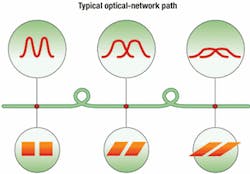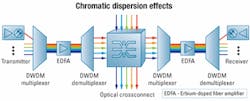Total performance monitoring solution guarantees network health
Today's measurement techniques can detect, locate, and isolate any faults in optical components critical to the metro core network.
DR. GORDON KNIGHT, Opthos Inc.
Traditionally, monitoring the performance of metropolitan networks has been through the examination of SONET headers at each node. While an end-to-end electrical measurement of bit-error rate (BER) will always be required to enforce service providers' service-level agreements, as soon as optical components-amplifiers, multiplexers, and switches-are added to the network, SONET is no longer adequate for fault detection and isolation.
Until recently, devices and tools have not been available to sufficiently monitor the optical fabric of these optically enhanced systems. That has resulted in significant problems maintaining these networks. The advent of a new generation of optical performance monitoring devices and a focus on the full network lifetime-from initial network engineering through dynamic performance monitoring through end-of-life-has changed the situation for metro core networks.
Most of the focus in optical networks has been on guarantees of BER and optical layer restoration techniques. These techniques are important, but for ease of maintenance, we must investigate not only the traditional fiber and equipment failures, but also degradations and failures of optical devices that can only be detected optically. That includes degradations and failures that may trigger restoration or other corrective actions such as detection and isolation down to the node and individual module level. To select the right cure, we must first examine sources of problems in a metro-area optical network and how they can be monitored.
Several sources of distortion affect signal quality, including chromatic dispersion (CD), polarization-mode dispersion (PMD), crosstalk, and four-wave mixing.
- CD is caused by differences in the speed of the light in fiber at different wavelengths and is dependent primarily on the fiber plant. CD causes distortion of the data bits. The rate of this chromatic dispersion change with wavelength, or the slope, is called slope distortion. CD effects are deterministic and do not change significantly with time.
- PMD distortion is caused by minute changes in the index of refraction within the fiber and in the optical components. Since the index of refraction can change with temperature and mechanical stress, PMD distortion is not deterministic but is statistical in nature and can change in seconds to minutes.
- Crosstalk occurs when traffic on one wavelength interacts with traffic on an adjacent wavelength. That can occur either within the fiber or within one optical element in the node.
- Four-wave mixing is a nonlinear distortion caused by very high powers and tight wavelength spacing within the fiber core. This distortion is statistical in nature and can vary with time.
Optical amplifiers such as erbium-doped fiber amplifiers (EDFAs) and semiconductor optical amplifiers add noise (amplified spontaneous emission-ASE) to the signal as it is amplified for transmission down a fiber or through a switching node. Since the noise from one EDFA is amplified by subsequent EDFAs, the ASE noise accumulates with the number of optical amplifiers. Noise is a major problem that must be addressed in network design, and noise monitoring must be a component of performance monitoring.
EDFAs react to changes in input power in a nonlinear manner. For example, the abrupt dropping of wavelengths going into an EDFA will result in at least a momentary boost in gain seen by the remaining wavelengths. Downstream amplifiers amplify this transient. These wavelength power transients can cause serious quality-of-service (QoS) degradation during the transient event and may cause equipment damage.The optical components in a network can degrade with time or fail outright. These component failures and degradations must be detected, located, and isolated before any significant changes occur in signal quality. Thus, the subtle effects of component degradation must be understood and monitored.
The total performance monitoring solution for a metro optical network combines proper network design to limit noise sources; continuous optical and electrical sensing of the active optical components within the network for fault detection and isolation; and the use of optical performance monitors throughout the network to monitor the per-wavelength optical signal-to-noise ratio (OSNR), power, and wavelength drift.
Individually, these three solutions cannot guarantee QoS, but when combined, they provide the solution for fault detection and isolation and QoS for the metro optical network. There are several parts to a total performance monitoring solution.
The metro optical network must be designed to limit distortions and noise buildup so an adequate signal-to-noise ratio can be maintained for the life of the network. Optical-network simulation tools and measurement techniques are available that can be used to ensure excellent signal quality as the network is initially designed and installed. However, this process is complex. Properly engineered network design tools and intelligent optical-network elements can significantly ease this process. Several issues must be addressed as part of the network design.
CD is the major distortion in both long-haul and the metro core. Fortunately, CD is deterministic, coming primarily from the fiber plant. Dispersion compensation modules (DCMs) must be placed at the proper locations to limit any CD buildup.
Although dynamic PMD compensation is becoming a major issue for long-haul networks, especially at OC-768 (40-Gbit/sec) data rates, available techniques are not economically viable in the metro core. Fortunately, PMD buildup can be limited by a proper metro-network design. PMD, however, is not deterministic. We do know what statistical level of PMD each optical component, including the transmission fiber, contributes. Bending of fibers and other dynamic effects also contribute to PMD. By accounting for all of these factors, a metro optical network can be designed so that dynamic PMD compensation is not required.The ASE noise is well characterized and can be added into the system model along with the above distortions. Intelligent electronics within optical amplifiers can handle transients in the metro core.
By detecting any change in input load, they adjust the pump-laser power to dampen out any optical gain transient. These optical feedback techniques are very effective in minimizing the transients caused by ad ding or dropping wavelengths at the network nodes.
There are several tools available to detect faults and degradations of the components, including output taps and detectors or electrical sensors that measure the status of a component. These continuous monitoring points can also detect upstream problems such as a fiber break or a change in insertion loss prior to the EDFA. Optical taps and detectors can be placed at the output of optical switches to detect their status.
With optical and electronic monitors from the optical components and a suitable selection of additional monitoring points, it's possible to build an optical network and monitor the status of all the optical devices within the network. That allows the optical-network controller to identify, locate, and isolate any failing component.
Optical performance monitors (OPMs) can be used to monitor degradations in optical components due to aging, temperature, and/or humidity variations as well as changes in insertion loss of the passive components. The OPM demultiplexes the wavelengths in the fiber or scans them onto a detector or detector array. An OPM can monitor the power, wavelength drift, and OSNR at each wavelength.
These measurements can be used to diagnose a range of problems. For example, if the OPM detects a change in a single-wavelength power or single-wavelength drift, the optical-network controller may conclude that a laser is failing and take appropriate actions. On the other hand, a change in all wavelengths is more likely a sign that an amplifier or multiplexer is failing.
The OPM device must have adequate over-sampling at the detectors so that the noise floor is accurately measured to provide a good measure of OSNR. The OPM must also have sufficient dynamic range to track the slow changes that can occur in the network.
Since most OPM devices are relatively slow, they are best used to measure slow changes within the network. The challenge for the optical-network designer is to limit these distortions and nonlinearities so that the time averaging measures of the OPM will provide a quality measure of the health of the network.
In any optically enhanced network, it is critical to monitor the performance at the optical layer. Measurement techniques are available to detect, locate, and isolate any faults in the optical components. In addition, by using OPMs at each node, an intelligent network element can now monitor slower changes in the signal and noise levels to detect any performance changes with time.
Dr. Gordon Knight is senior director of optical technology and architecture at Opthos Inc. (San Carlos, CA). He can be reached via the company's Website, www.opthos.com.


